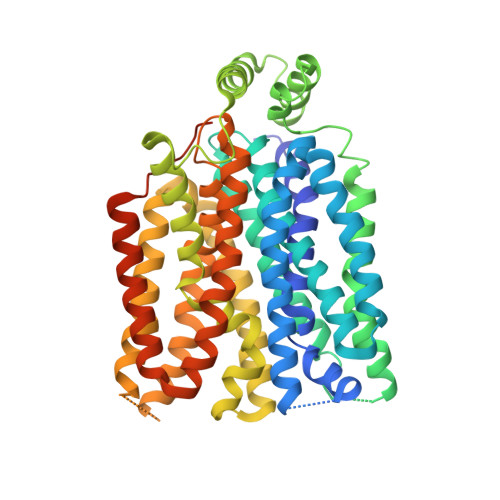The molecular basis for sugar import in malaria parasites.
Qureshi, A.A., Suades, A., Matsuoka, R., Brock, J., McComas, S.E., Nji, E., Orellana, L., Claesson, M., Delemotte, L., Drew, D.(2020) Nature 578: 321-325
- PubMed: 31996846
- DOI: https://doi.org/10.1038/s41586-020-1963-z
- Primary Citation of Related Structures:
6RW3 - PubMed Abstract:
Elucidating the mechanism of sugar import requires a molecular understanding of how transporters couple sugar binding and gating events. Whereas mammalian glucose transporters (GLUTs) are specialists 1 , the hexose transporter from the malaria parasite Plasmodium falciparum PfHT1 2,3 has acquired the ability to transport both glucose and fructose sugars as efficiently as the dedicated glucose (GLUT3) and fructose (GLUT5) transporters. Here, to establish the molecular basis of sugar promiscuity in malaria parasites, we determined the crystal structure of PfHT1 in complex with D-glucose at a resolution of 3.6 Å. We found that the sugar-binding site in PfHT1 is very similar to those of the distantly related GLUT3 and GLUT5 structures 4,5 . Nevertheless, engineered PfHT1 mutations made to match GLUT sugar-binding sites did not shift sugar preferences. The extracellular substrate-gating helix TM7b in PfHT1 was positioned in a fully occluded conformation, providing a unique glimpse into how sugar binding and gating are coupled. We determined that polar contacts between TM7b and TM1 (located about 15 Å from D-glucose) are just as critical for transport as the residues that directly coordinate D-glucose, which demonstrates a strong allosteric coupling between sugar binding and gating. We conclude that PfHT1 has achieved substrate promiscuity not by modifying its sugar-binding site, but instead by evolving substrate-gating dynamics.
- Department of Biochemistry and Biophysics, Stockholm University, Stockholm, Sweden.
Organizational Affiliation:


















